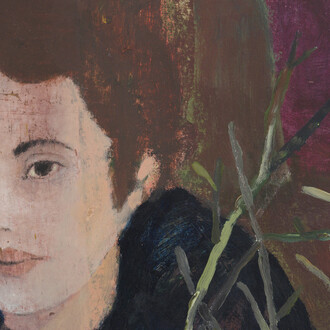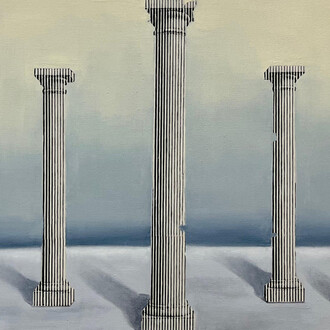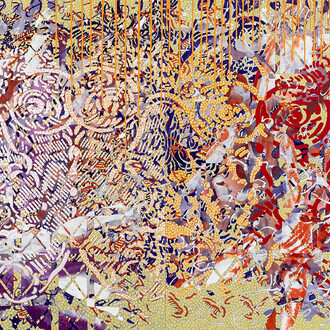Around La salle de jeux (1998), a historic and participatory piece by Rirkrit Tiravanija, the gallery presents a selection of works by Abraham Cruzvillegas and Danh Vo.
Abraham Cruzvillegas. Since 1985, his drawings, paintings, and silkscreens of primates—inspired by his fascination with gorillas—have become metaphors for the human condition. In Autorretrato oponible actual, 31 (2023) the artist observes the similarities between these animals and his loved ones, weaving a link between animality and humanity. Through these simian figures, he questions his own reflection, blurring the boundaries of human and animal.
In the series Blind self portrait, he pursues an introspective exploration by covering elements of daily life with paint: personal documents, press clippings, flyers or found objects. These supports are masked under a layer of acrylic, erasing their visible content. Arranged in a composition that is both chaotic and rigorously structured, these fragments create a “blind self-portrait” in which meaning is deliberately blurred, allowing a form of abstract introspection.
With the installation Empty lot, presented in 2015 at Tate Modern, Abraham Cruzvillegas directly addresses the tension between nature and urbanization. Through a geometric arrangement of planters filled with soil but initially empty, he invites nature to take root in the heart of the city. The spontaneous growth of plants, made possible by a lighting and irrigation system, becomes a metaphor for constant transformation, latent potential, and the unpredictability of living things.
Abraham Cruzvillegas explores the complex relationships between human being, identity and nature. By articulating representations of primates, abstract self-portraits and sculptural installations, he builds a body of work centered on identity in constant evolution. The artist explores the shifting links between the individual and his or her their environment—whether natural, urban, or social—and invites us to rethink the invisible connections that shape our identities, and to see the coexistence of nature, culture, and memory as a constantly evolving process.
Rirkrit Tiravanija. La salle de jeux (1998) by Rirkrit Tiravanija evokes a café or clubhouse—social settings where people meet to drink tea, watch television, play cards or share memories. A selection of games, DVDs and CDs is made available, and visitors are invited to take over the exhibition space as they wish. A corkboard, ready to receive any notes or drawings guests feel like posting, further encourages social exchange.
Since the late 1990s, Tiravanija has produced participatory installations that offer visitors platforms for expression within the exhibition itself, asserting the gallery as a place for encounter and sharing. Informed by artistic precedents such as the happenings of the 1960s, participatory art upends conventional understandings of the artwork and questions prevailing social conventions. The artist steps aside to allow visitors to take ownership of the space and, in doing so, bring the work to life.
Danh Vo. Untitled (2023) brings together twelve photographs of flowers by Danh Vo. Beneath each image the artist’s father, Phung Vo, has handwritten the first part of the flower’s Latin name, thus extending the father-son collaboration best known through 2.2.1861 (2009-), in which Phung copies the farewell letter French missionary Théophane Vénard sent to his own father before being executed by Buddhist monks in Vietnam. A Catholic refugee now living in Denmark, Phung has made this transcription both a source of income and a form of prayer.
Danh Vo’s interest in flower photography began with the series untitled (2021), shot on his iPhone in the gardens of Güldenhof (Germany) and Pantelleria (Italy). Around the same time he became close to a German-Vietnamese family of florists, offering them the use of the storefront beneath his Berlin apartment. At first he supplied them with flowers from Güldenhof, but these non-commercial varieties were considered too irregular for sale. This realisation deepened Vo’s curiosity about floral species and ultimately led to untitled (2023). The series portrays cut flowers from the shop, often photographed in sparse, isolated settings—a single rose on a scale, a carnation placed on bare wood. The Latin name written beneath each image raises questions about power and cultural hierarchies, a theme also reflected in the choice of frames. These were made from black walnut wood given to the artist by Craig McNamara, son of Robert McNamara, the U.S. Secretary of Defense, who played a central role in the Vietnam War—the conflict that led to Vo’s family’s exile. By using wood from the McNamara estate, the artist draws attention to the historical events that shaped his family’s displacement.
















